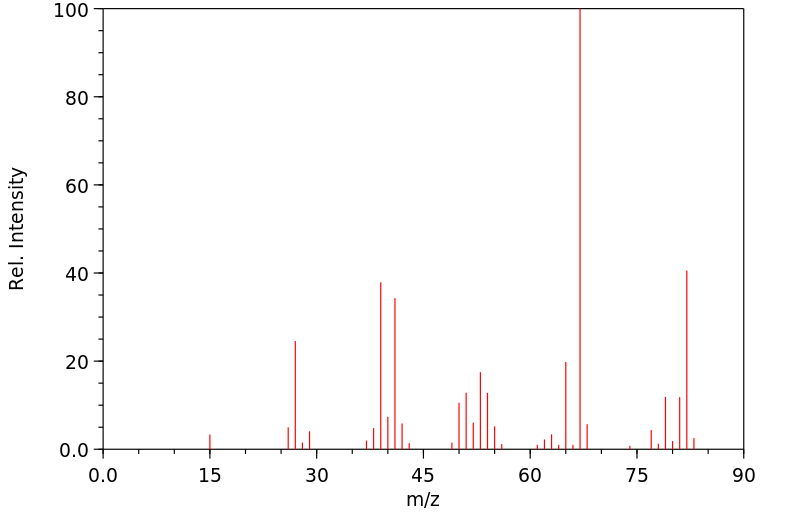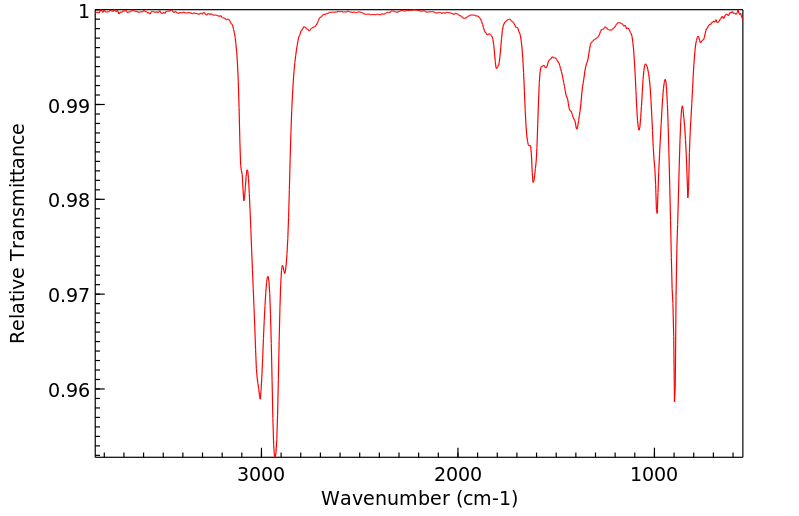(3Z)-3-甲基戊-1,3-二烯 | 2787-45-3
中文名称
(3Z)-3-甲基戊-1,3-二烯
中文别名
——
英文名称
(Z)-3-methyl-1,3-pentadiene
英文别名
(3Z)-3-Methyl-1,3-pentadiene;methyl-3 pentadiene-1,3 cis;Z-3-methyl-1,3-pentadiene;(Z)-3-methyl-penta-1,3-diene;3-Methyl-cis-pentadien-(1,3);cis-3-Methyl-pentadien-(1,3);cis-3-Methyl-1,3-Pentadiene;(3Z)-3-methylpenta-1,3-diene
CAS
2787-45-3
化学式
C6H10
mdl
——
分子量
82.1454
InChiKey
BOGRNZQRTNVZCZ-WAYWQWQTSA-N
BEILSTEIN
——
EINECS
——
-
物化性质
-
计算性质
-
ADMET
-
安全信息
-
SDS
-
制备方法与用途
-
上下游信息
-
文献信息
-
表征谱图
-
同类化合物
-
相关功能分类
-
相关结构分类
物化性质
-
熔点:-94.9°C (estimate)
-
沸点:70.05°C (estimate)
-
密度:0.7300
-
保留指数:643
计算性质
-
辛醇/水分配系数(LogP):2.7
-
重原子数:6
-
可旋转键数:1
-
环数:0.0
-
sp3杂化的碳原子比例:0.33
-
拓扑面积:0
-
氢给体数:0
-
氢受体数:0
安全信息
-
海关编码:2901299090
SDS
反应信息
-
作为反应物:参考文献:名称:HEASLEY G. E.; SMITH D. A.; SMITH J. N.; HEASLEY V. L.; SHELLHAMER D. F., J. ORG. CHEM., 1980, 45, NO 25, 2506-2509摘要:DOI:
-
作为产物:描述:参考文献:名称:有机反应中的金属催化。第13部分。3-烯-1-炔与三烷基丙二烯的反应:过渡金属配合物的影响摘要:三烷基丙氨酸与3-烷基-,4-烷基-或3,4-二烷基-丁-3-烯-1-炔(1)之间的反应产生对应于金属化,还原和碳铝化过程的产物。这种反应的程度以及碳氨化的区域选择性和立体选择性取决于所用的烯炔。提出了一种机制,涉及几种α-不饱和有机铝中间体之间的互变异构体平衡,以解释碳酰化产物的形成。DOI:10.1039/p19810001900
-
作为试剂:描述:一氧化碳 、 2,3-二苄基-1,3-丁二烯 、 1,4-二甲氧基-2-丁炔 在 di(rhodium)tetracarbonyl dichloride 、 (3Z)-3-甲基戊-1,3-二烯 作用下, 以 1,2-二氯乙烷 为溶剂, 60.0 ℃ 、101.32 kPa 条件下, 反应 9.0h, 以81%的产率得到5-Benzyl-5-(1-benzyl-vinyl)-2,3-bis-methoxymethyl-cyclopent-2-enone参考文献:名称:分子间二烯基Pauson-Khand反应。摘要:DOI:10.1002/anie.200454117
文献信息
-
Conversion of 2-alkenylcyclopropylcarbene-chromium complexes to 5-alkenyl-2-cyclopentenones: A stereospecific three- to five-carbon ring expansion reaction作者:James W. Herndon、David K. Hill、Leonard A. McMullenDOI:10.1016/0040-4039(95)01124-z日期:1995.8Upon thermolysis, 2-alkenylcyclopropylcarbene-chromium complexes are converted to 5-alkenyl-2-cyclopentenones. The reaction appears to proceed with retention of configuration in the absence of steric factors.
-
Synthesis and1H-,13C-, and57Fe-NMR spectra of mono- and bis[tricarbonyl(?4-diene)iron], and (?3-allyl)tetracarbonyliron trifluoroborate complexes作者:Christoph M. Adams、Giovanni Cerioni、Andreas Hafner、Hermann Kalchhauser、Wolfgang von Philipsborn、Roland Prewo、Andreas SchwenkDOI:10.1002/hlca.19880710526日期:1988.8.10with a (Z)-configuration terminal Me group show steric inhibition of metal complexation resulting in lower yields and formation of tetracarbonyl(η2-diene) and tricarbonyl(η4-heterodiene) complexes as additional products. Regioselective attack by C-nucleophiles at the carbonyl C-atoms of the functional group with or without concomitant 1,3 mogration of the Fe(CO)3 group was used to synthesize polyenes and多种单-和双[铁(CO)的3(η 4 -二烯)]配合物的烷基,CH 2 OH,CHO,COCH 3,1,3-二烯系统上COOR,和CN的取代基已被合成。用(Z) -构型终端Me基团的二烯显示金属络合的空间抑制从而导致较低的产率和形成的四羰(η 2 -二烯)三羰基和(η 4 -heterodiene)络合物作为附加产品。C-亲核试剂在官能团的羰基碳原子上的区域选择性攻击(带有或不带有Fe(CO)3基团的1,3迁移)被用于合成多烯和类异戊二烯结构单元,如单或双核Fe(CO)3复合体。Fe(co)3复杂的合成子的Wittig - Horner型反应导致立体构象形成(E)构型的烯烃。报告了烯烃和烯丙基有机铁配合物的1 H-,13 C-和57 Fe-NMR光谱,已评估H,H,C,H和C,C偶联常数,并根据其几何形状进行了分析。配位二烯。三羰基[3-6-η-(((E)-6-甲基-3,5-庚二烯-2-一
-
Stannyldienes, new tools for organic synthesis. preparatiom and reactivity作者:Cristina Nativi、Maurizio Taddei、André MannDOI:10.1016/0040-4020(89)80022-5日期:1989.1for a regiocontrolled transfer of the dienic structure by : a)tin-lithium exchange and further reaction with aldehydes to give conjugated dienic alcohols; b)coupling with acyl chlorides in the presence of palladium catalysts to give conjugated dienic ketones; c) AlCl3, promoted reaction with acyl chlorides to give allenic ketones.
-
Catalytic cross-dimerisation giving reactive borylated polyenes toward cross-coupling作者:Masafumi Hirano、Ayumi Kuramochi、Keita Shimada、Nobuyuki Komine、Sayori Kiyota、Stephen A. WestcottDOI:10.1039/c9cc05930j日期:——
A series of borylated conjugated trienes and skipped dienes is prepared by Ru-catalysed cross-dimerisation using alkynyl-, dienyl-, and vinyl boronates.
-
A Series of Crystallographically Characterized Linear and Branched σ-Alkane Complexes of Rhodium: From Propane to 3-Methylpentane作者:Alexander J. Bukvic、Arron L. Burnage、Graham J. Tizzard、Antonio J. Martínez-Martínez、Alasdair I. McKay、Nicholas H. Rees、Bengt E. Tegner、Tobias Krämer、Heather Fish、Mark R. Warren、Simon J. Coles、Stuart A. Macgregor、Andrew S. WellerDOI:10.1021/jacs.1c00738日期:2021.4.7(3-methylpentane). For the linear alkanes propane and hexane, some additional Rh(I)···H–C interactions with the geminal C–H bonds are also evident. The stability of these complexes with respect to alkane loss in the solid state varies with the identity of the alkane: from propane that decomposes rapidly at 295 K to 2-methylbutane that is stable and instead undergoes an acceptorless dehydrogenation to form a bound alkene利用固态分子有机金属(SMOM)技术,特别是固/气单晶到单晶的反应性,一系列通式为[Rh(Cy 2 PCH 2 CH 2 PCy 2 )(η已经制备了n :η (间烷)][BAr F 4 ](烷烃=丙烷、2-甲基丁烷、己烷、3-甲基戊烷;Ar F =3,5-(CF 3 ) 2 C 6 H 3 )。这些新配合物已使用单晶 X 射线衍射、固态核磁共振波谱和 DFT 计算技术进行了表征,并在金属配位位点呈现出多种 Rh(I)·H–C 结合基序:1,2- η 2 :η 2 (2-甲基丁烷)、1,3-η 2 :η 2 (丙烷)、2,4-η 2 :η 2 (己烷)和1,4-η 1 :η 2 (3-甲基戊烷)。对于直链烷烃丙烷和己烷,一些额外的 Rh(I)…H-C 与偕 C-H 键的相互作用也很明显。这些络合物相对于固态烷烃损失的稳定性随烷烃的特性而变化:从在 295 K 下快速分解的丙烷到稳定的 2-
表征谱图
-
氢谱1HNMR
-
质谱MS
-
碳谱13CNMR
-
红外IR
-
拉曼Raman
-
峰位数据
-
峰位匹配
-
表征信息
同类化合物
高密聚乙烯
香叶醇
顺式3-甲基-2-己烯
顺式-5-癸烯
顺式-5-甲基-2-己烯
顺式-5-庚烯-1-炔
顺式-4-癸烷
顺式-4-甲基-2-戊烯
顺式-4-甲基-2-戊烯
顺式-3-癸烯
顺式-3-甲基-3-己烯
顺式-3-甲基-2-庚烯
顺式-3-戊烯-1-炔
顺式-3,4-二甲基-3-己烯
顺式-3,4-二甲基-2-戊烯
顺式-3,4-二甲基-2-戊烯
顺式-2-甲基-3-己烯
顺式-2-壬烯
顺式-2-丁烯-D1
顺式-1.1.1-三甲基-2-丁烯
顺式-1-甲基-2-环丙基乙烯
顺式-1-甲基-2-乙烯基环戊烷
顺式-1-环戊基-1-辛烯
顺式-1-氘代-3-甲基-1-丁烯
顺式-(9ci)-2,3,3a,7a-四氢-4-(1-甲基乙基)-1H-茚
顺式-(2-丁烯基)环丙烷
顺式,顺式-2,4-己二烯
顺-环辛烯
顺-9-二十一碳烯
顺-6-十三碳烯
顺-5-甲基-1,3,6-庚三烯
顺-4-辛烯
顺-4-壬烯
顺-3-辛烯
顺-3-甲基-2-戊烯
顺-3-壬烯
顺-3-十三碳烯
顺-2-辛烯
顺-2-癸烯
顺-2-戊烯
顺-2-庚烯
顺-2-己烯
顺-2-丁烯
顺-2,2-二甲基-3-己烯
顺-1,3-戊二烯
顺,顺-1,9-环十六烷二烯
顺,顺,顺-环癸-1,3,5-三烯
间戊二烯
间二(4-吡啶基)苯
镁,二-2-丁烯基-









